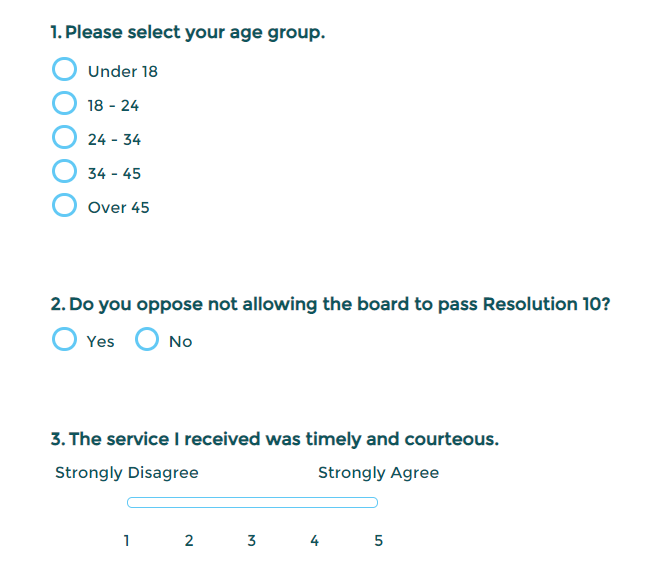Pay close attention to the language of your surveys; both questions and answer options are critical. Sometimes, we inadvertently phrase questions in a way that confuses or misleads people into making answer choices that are incorrect. Avoid this common survey design mistake by a careful review.
Here’s a quick test: What’s wrong with the questions below?

As you may be able to see here, a few common issues we see in survey question development include overlapping answer options, double-negative questions, and double-barreled questions.
What are overlapping answer options?
A sloppy mistake that survey designers make is including overlapping answer options. This is a common oversight and can confuse the participants who may fall in multiple categories.
Answer options in Question 1 provides an example of a set of overlapping answer options. If a participant is 24, should she choose the second or third option? If a participant is 34, should he choose the third or fourth? The inconsistency with which participants are likely to decide means that the data collected is unhelpful.
What is a double-negative question?
A double-negative question includes two negative words, potentially confusing or misleading the participant completely. If a participant can’t understand the question, of course, their answer will be meaningless and the resulting data will be useless.
Question 2 is an example of a double-negative question. If you know what that question is asking, good for you! Each participant is likely to interpret the question differently — not helpful for data validity.
What is a double-barreled question?
Including a double-barreled question is one of the most common issues users have in building their surveys, and it can be easy for inexperienced survey designers to overlook and fail to correct. In this type of mistake, the participant is asked about two separate things simultaneously, which means that it will be unclear whether the answer given applies to one or both parts. Again, this issue means that the answers to this question cannot be used in meaningful analysis.
Question 3 is a classic double-barreled question — ambitious but misguided. What is actually being measured here?
If someone agrees with this statement, are they saying that the service was both timely and courteous? What if the service I received was timely but not courteous, or vice versa? A simple point on a rating scale cannot possibly represent the whole range of options.
Discuss Survey Types and Tailored Question Design
- Customer Satisfaction Surveys: Use clear, concise questions to gauge satisfaction levels.
- Employee Feedback Surveys: Ensure anonymity to encourage honest responses.
- Market Research Surveys: Avoid leading questions to gather unbiased data.
- Educational Assessments: Use age-appropriate language and consider the cognitive load on respondents.
Introduce Survey Design Best Practices
- Clarity: Ensure questions are straightforward and unambiguous.
- Neutrality: Avoid leading or loaded questions that may bias responses.
- Simplicity: Keep questions concise to maintain respondent engagement.
- Pilot Testing: Test the survey with a small group to identify potential issues before full deployment.
- Logical Flow: Organize questions in a sequence that feels natural to the respondent.
Check, double check, and check again
Once you become familiar with these common errors, you will be able to avoid them more easily. These are easy checks that can be made at the time of reviewing the survey questions. While it might take time to review your questions multiple times, it’s certainly more efficient than asking the wrong questions and receiving unhelpful or meaningless results — and then having to start again from the top.
Frequently Asked Questions
What is a double-barreled question in a survey?
A double-barreled question combines two distinct topics into one, forcing respondents to answer ambiguously, e.g., “How satisfied are you with our product’s price and quality?”. This conflates issues, making results unreliable—someone unhappy with price but happy with quality can’t clarify. Keep questions singularly focused to ensure clear, actionable insights.
How can I avoid overlapping answer options in surveys?
Ensure answer choices are mutually exclusive by using precise categories. Avoid vague terms like “sometimes” or “frequently” without definitions. Pre-test surveys to catch overlaps and use scales for nuanced opinions. Simplify complex questions by splitting them into multiple items, ensuring each option captures a unique response.
Why are double-negative questions problematic?
Double negatives confuse respondents, leading to misinterpretation and skewed data. They force users to untangle contradictory phrasing, increasing cognitive load and error rates. Replace with direct language to ensure clarity, reduce frustration, and gather accurate, honest feedback.






